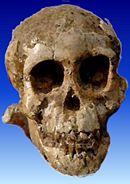- Selam (Australopithecus)
-
Selam Catalog number DIK-1/1 Common name Selam Species Australopithecus afarensis Age 3.3 mya Place discovered Dikika, Afar Depression, Ethiopia Date discovered 2000 Discovered by Zeresenay Alemseged
Selam (DIK-1/1) is the fossilized skull and other skeletal remains of a 3-year-old Australopithecus afarensis female whose bones were first found in Dikika, Ethiopia in 2000 and recovered over the following years. She is often nicknamed Lucy's baby. The remains have been dated at 3.3 mya, approximately 120,000 years older than "Lucy" (dated to about 3.18 Ma). The fossils were discovered by Zeresenay Alemseged, and are remarkable for both their age and completeness.On September 20, 2006, the journal Nature presented the findings of a dig in Dikika, Ethiopia, a few miles south (across the Awash River) from Hadar, the place where the fossil remains known as Lucy was found. The recovered skeleton comprises almost the entire skull and torso, and many parts of the limbs. The features of the skeleton suggest adaptation to walking upright (bipedalism) as well as tree-climbing, features that correspond well with the skeletal features of Lucy and other specimens of Australopithecus afarensis from Ethiopia and Tanzania. "Lucy's Baby" has officially been nicknamed "Selam" (meaning "peace").
The following is the abstract of the original article describing the baby, which was authored by Zeresenay Alemseged, Fred Spoor, William H. Kimbel, René Bobe, Denis Geraads, Denné Reed and Jonathan G. Wynn, and appeared in Nature on September 20, 2006.[1]
“ Understanding changes in ontogenetic development is central to the study of human evolution. With the exception of Neanderthals, the growth patterns of fossil hominins have not been studied comprehensively because the fossil record currently lacks specimens that document both cranial and postcranial development at young ontogenetic stages. Here we describe a well-preserved 3.3-million-year-old juvenile partial skeleton of Australopithecus afarensis discovered in the Dikika research area of Ethiopia. The skull of the approximately three-year-old presumed female shows that most features diagnostic of the species are evident even at this early stage of development. The find includes many previously unknown skeletal elements from the Pliocene hominin record, including a hyoid bone that has a typical African ape morphology. The foot and other evidence from the lower limb provide clear evidence for bipedal locomotion, but the gorilla-like scapula and long and curved manual phalanges raise new questions about the importance of arboreal behaviour in the A. afarensis locomotor repertoire. ” A life like image of Selam was published on the front page of the November 2006 issue of National Geographic.
Contents
Evolution
Many paleoanthropologists propose that the homo line derives from A. africanus, in this view it might be better to place Selam in the A. africanus line since it has more human traits than most A.afarensis (see Homininae).
See also
- Taung Child (Australopithecus africanus)
- List of fossil sites (with link directory)
- List of hominina (hominid) fossils (with images)
- Homininae
References
- ^ Alemseged, Zeresenay; et al. (2006). "A juvenile early hominin skeleton from Dikika, Ethiopia". Nature 443 (7109): 296–301. doi:10.1038/nature05047. PMID 16988704.
External links
This prehistoric primate-related article is a stub. You can help Wikipedia by expanding it.


